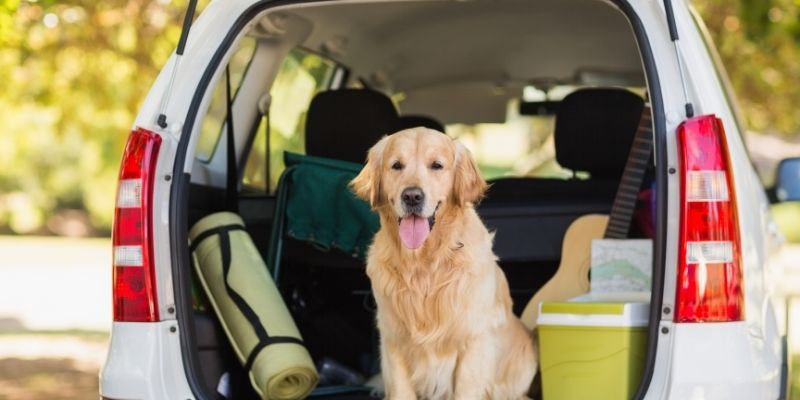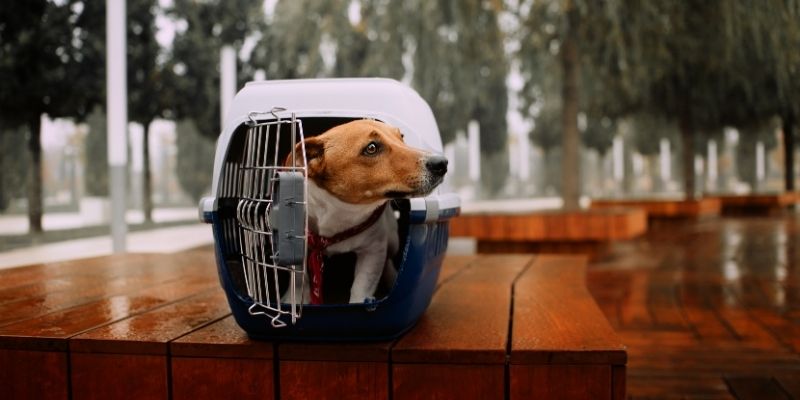According to the International Pet and Animal Transportation Agency, over 4 million pets are transported via air worldwide each year. The fact that there is a whole agency around this demonstrates how vital pet travel is. If you’re going to join the number of people bringing their dog along for trips, you’re going to need a dog travel crate. Even for car trips, the longer it is, the more likely you will be to appreciate a crate.
Before you bring your dog along with you for a flight, you’ve got to make sure you know all the prerequisites for pet travel. Even the CDC (The Centers for Disease Control and Prevention ) accepts that your animal’s comfort is very essential, and that’s the most critical function of a travel crate for dogs. This article is here to tell you everything you need to know about travel crates before your trip.
Do you have a specific question about dog travel crates? Then use the table of contents below to jump to the most relevant section. And you can always go back by clicking on the black arrow in the right bottom corner of the page. Also, please note that some of the links in this article may be affiliate links. For more details, check the Disclosure section at the bottom of the page.
Here's what we'll cover:
- Do you bring a crate when traveling with a dog?
- How safe is a dog traveling in a dog crate?
- What is the right size travel dog crate?
- What size pet traveling crate do I need for a 50-pound dog?
- How to measure a dog for a travel crate?
- How to train a dog to stay in a crate for travel?
- Why does my dog go in her travel crate?
- Where to put a dog crate when traveling?
- What is the lightest dog crate for air travel?
- What should be in a dog crate for international travel?
- How to secure a dog crate in a car when traveling?
- How to choose a dog travel crate?
Do you bring a crate when traveling with a dog?

The answer to this depends on the means of travel. If it’s by car, then you can get away with foregoing a crate, particularly with well-trained dogs. Longer trips will have you grateful for a crate, as it can keep restless dogs safer. However, with air travel, you will need it. Whether your dog will be staying in the cargo hold or as a carry-on, you’ll require a crate or carrier.

How safe is a dog traveling in a dog crate?
Having your pet travel in a dog travel crate is always safer than the alternative of having them roaming free. In a car, sudden stops can cause serious injury to your dogs, and smaller canines can get in the way while driving, which can be very unsafe. During air travel, the cargo hold may sometimes have cargo shifting around or falling. Good travel crates for dogs will protect against any of these hazards and keep your dog safe within.

What is the right size travel dog crate?

This step is more important than it might seem. That’s because the International Air Transport Association (IATA) will want to ensure that the crate you have is optimally sized for your dog. A too-small kennel will squeeze on your pal and cause discomfort, and a big one will have your dog being flung around within it. Using certain formulas, you can figure out the optimal dimensions for a crate for your dog. They are as follows:
- Length: A + B/2
- Width: C x 2
- Height: D
The dimensions that these letters represent are explained under the question of measurement.

What size pet traveling crate do I need for a 50-pound dog?
Getting the perfect sized crate for a 50-pound dog is more dependent on the animal’s measurements. Still, a unit designated as ‘large’ is likely to be good. However, if possible, measure your dog so you can get the exact details and a perfect fit for a travel dog crate.

How to measure a dog for a travel crate?
To get the values indicated in calculating the right size of crate for your dog, you will need to measure your canine friend. These are the areas measured for each letter:
- From the tip of the nose to the base (not the tip!) of the tail. (A)
- From the elbow joint in the front legs to the ground. (B)
- Measure from shoulder to shoulder. (C)
- For a dog that is standing erect, a measurement from the top of the canine’s head to the ground. (D)
Simply plug in these values to the formula to find a perfect fit when looking for a large dog travel crate.

How to train a dog to stay in a crate for travel?

If possible, purchase a travel crate as soon as you realize that you will be traveling. This gives you the time to crate train your dog and get used to it. You’ll also be able to measure your dog and take the time to find a perfectly sized travel dog crate. The following steps can help you crate train:
- Get your pet used to the crate. You can remove the top half of the crate and place it in your dog’s favorite area. You might notice that it’ll start spending time inside the crate on its own. You can put treats and toys in there to speed up the process. Sequentially add the top after some time and the door after some more time.
- Encourage the dog to stay in the crate. Like putting treats and toys in it, you can also put their food and meal bowls closer to it gradually, and eventually inside it.
- Reward them for spending time in the crate with treats and positive words.
- Try closing the door while they are inside and eventually driving around with them.

Why does my dog go in her travel crate?
You might notice that your dog seems to like its crate a bit too much. This might seem like a bad thing, but it stems from the natural instincts of these animals. Dogs are naturally denning animals, which means they like cozy, snug places to rest in. A crate, if perfectly sized and laid with a comfortable bed, will fit these criteria perfectly. So, you’ve done a good job if your dog loves its crate. You’ve given it a homely sanctuary!

Where to put a dog crate when traveling?
According to the ASPCA, the best place to put travel crates for dogs when traveling by road is in a car’s back seat. Or in the cargo section of any vehicle with one, such as an SUV or a station wagon. It should never be placed on the front seat, as airbags deploying during an accident can have serious consequences.

What is the lightest dog crate for air travel?

If you need a lightweight crate for your carrying your dog, one made of sturdy plastic is your best bet. Plastic is lighter than metal and can be strong enough to support your pet’s weight when carried.
There are fabric carriers, but these are not very suitable for dogs kept in a cargo hold. For smaller dogs that will stay with you in the cabin, the fabric is a great lightweight option when looking at dog travel crates. So I am sure it’s possible to find something that works for you and your pup.

What should be in a dog crate for international travel?

If you’ve never traveled overseas with your dog, you may be lost on what exactly you need to include in its crate. Fortunately for you, I will tell you the essential things to be included in a travel crate for dogs. These are the following:
- Food and water bowls: These must be attached to the inside of the crate door. This allows the airline workers to refill water or food very conveniently.
- Food: In the case of long flights, delays, or layovers, you can tape a pack of dog food to the top of the crate. This way, the airline workers can feed your pet if there’s any need for that.
- A pet pad or shredded newspaper should be placed on the bottom of the crate. This will help absorb any pee or spilled water.
- Though not an absolute requirement, tape a piece of paper with your contact information, as well as your dog’s name and possibly picture. This will be very helpful if your dog somehow escapes from its crate.

How to secure a dog crate in a car when traveling?
Knowing how to secure dog travel crates if you’ll frequently be putting your pets in the cargo section or back seat of a car is essential. This will make sure the crate doesn’t move around too much in transit, which can cause injury or make your pet anxious.
One way you can secure a small crate is to simply buckle it in with a seat belt. This won’t work for a large dog travel crate, so only consider this option for small ones. It lengthwise, pass the belt through the strap or handle, and buckle it in.
You can buy safety straps that can be clipped onto your dog’s crate and buckled into the seat as a seatbelt would. This is a good option for large dog crates. You can also strap down by tying a safety belt to any metal brackets or safety straps available in your vehicle, typically in the cargo section.

How to choose a dog travel crate?

The primary consideration you should have when buying a travel crate is to ensure that it is appropriately sized. Above, I showed you how to measure your dog and calculate the perfect unit’s ideal dimensions. It should not be too small or too big.
The material it is made of is also critical. Cloth crates shouldn’t be used for air travel or for carrying for long periods. For a trip on a plane, plastic crates are always the best choice. They are sturdy, light, and are best for travel in all situations.
Thanks for the blog graphics: Canva.com


